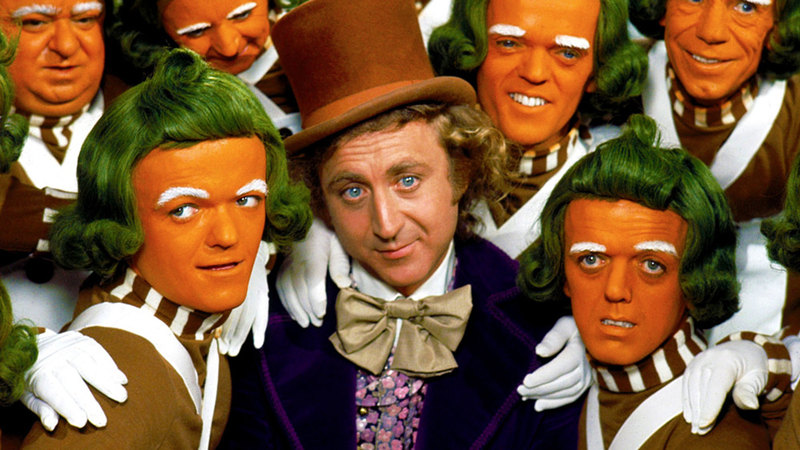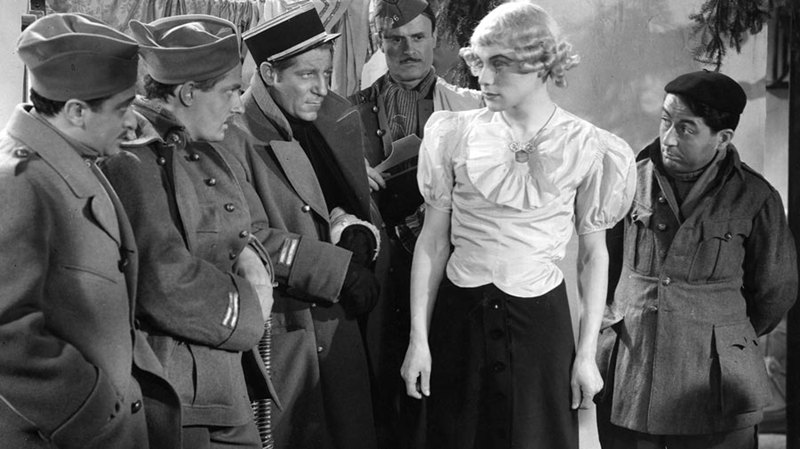Films described as “raunchy,” “erotic,” or “bawdy” usually send me running for cover. I’ve always thought this was because I am exceedingly old-fashioned in my sensibilities, but in the context of Pier Paolo Pasolini’s “Trilogy of Life,” perhaps I should say I am actually far too modern in my prudishness.
All three of Pasolini’s films are set in a medieval era that, for him, is characterized by an innocent, free-form sexuality, a world where everyone is shtupping everyone else without the slightest sign of self-consciousness, guilt or any concern about definitions or propriety. This partly explains why the trilogy’s dominant motif is that of smiling faces; great toothy smiles unsullied by dental hygiene flow unceasingly across the screen. Smiles everywhere; the smiles of the just-laid, the just-about-to-get-laid, or the just-thinking-about-getting-laid; a parade of smiles equally divided among men and women, leaning towards the young and fit but not excluding the senior generation.
Sometimes the smiles are not quite so innocent, like the grinning crowds who watch a woman brutally whipped or a man burned to death for the crime of homosexuality, but smiles, always smiles from start to finish. And constant giggling as if everyone shares a secret joy even in the face of privation. Pasolini claimed a disgust with modern consumerism and a need to retreat into nostalgia, though it’s clear that his re-creation is of an imaginary world, not one he believes really existed. And the Trilogy is, by no means, all fun and games. This is Pasolini, after all.
Pasolini was a intellectual juggernaut in post-war Italy, achieving fame and influence as a poet, novelist, critic, and political theorist in addition to his film work. I wonder if he was even the least bit intimidated by the seemingly Herculean labors he chose for himself: adaptations of three of the most important collections of stories ever written, works that had shaped cultures and languages: “The Decameron,” “Canterbury Tales” and “One Thousand and One Nights” (known better in English as “The Arabian Nights.”) He had already tackled The Greatest Story Ever Told in “The Gospel According to St. Matthew” (1964), so what’s a little Boccaccio or Chaucer between friends?
“The Decameron” (1971) is the most ebullient of the bunch, depicting 14th century Neapolitans (Pasolini relocated the stories from Florence to Naples) as a pragmatic bunch who know to get their kicks. When a deaf-mute gardener is taken in at a convent, the nuns decide to find out if the stories they’ve heard about the pleasures men can provide are true. When reminded of her vows, one sister shrugs it off: “We make promises to God every day we don’t keep!” In an even less pious frame of mind, a dying criminal decides to have fun by convincing a naïve priest that he was really a pious and noble man. He figures he’s committed so many sins, what’s one more going to hurt? Vows of all kinds are broken and rumpy-pumpy is enjoyed by all, with genitalia on display almost as prominently as the smiles they produce.
The mood turns a bit more dour in “The Canterbury Tales” (1972) though there is still plenty of carnal fun to be had. Pasolini casts himself as Geoffrey Chaucer (he also appeared in “The Decameron” as a disciple of the painter Giotto) but usually stays out of the way as nine of the Tales unspool, most focusing on people trying to get into each other’s various trousers and/or pantaloons. The tales range in tone and style from the silent slapstick comedy of “The Cook’s Tale” to “The Summoner’s Tale” which takes us directly to Hell, an all-too-brief fantasia in which devils shit out endless sprays of friars and other holy men across a barren landscape scraped raw by the constant gale force wind of a thousand Satanic farts. There is farting aplenty in the other Tales too, as well as more genitalia: it’s all one long schlong song. And it’s enough to keep everyone smiling.
“Arabian Nights” (1974) is the most linear of the films, following the story of a young man in love with a beautiful slave woman who is kidnapped from him. As he seeks her out, he finds himself in demand by just about everyone he encounters. He is constantly referred to as handsome though, to me, he looks like the creepy guy who works at Watch Hut and is really into anime. Of course, Pasolini focuses only on the most erotic of the traditional stories, most of which involve young people getting naked and getting it on, sometimes while others are watching. And, you guessed it, there are smiles all around.
“The Decameron” was very successful and spawned a new sub-genre of Italian softcore porn disguised as literary adaptation, much to Pasolini’s horror. A few years later, he was moved to issue an “abjuration” of his Trilogy, and his final film, the all-time transgressive shocker “Salo” (1975) was, in part, a reaction to what he viewed as the “commodification” of sex and the human body that was on display in some of the pornographic imitators.
Pasolini’s celebration of guilt-free sexuality and the unfettered human body is not suited to my tastes. I like my Catholic-inspired sexual guilt, pathological modesty, and unrelenting admiration for the virtues of monogamy just fine, thank you, but I respect his project as well as his extraordinary artistry. And I actually enjoyed “The Decameron” quite a bit for its blasphemous, ribald, good-natured humor that rings true. I find myself thinking back to one of the early scenes in which a young man (played by Ninetto Davoli, then Pasolini’s partner though they would break up during the production of “Canterbury”) is called to the home of a mysterious beautiful woman. He enters her room with a big-old “I’m gonna get me some” smile, but then she informs him that she is actually his long-lost sister. Davoli sits, patiently listening to her tale, all the while with the unmistakable look of a man who is waiting for his boner to subside. Been there, brother, been there.
Video:
All three films are presented in their original 1.85:1 aspect ratios and each of the digitally restored transfers were created from 35 mm interpositives. In general, the quality is excellent throughout the set, with some damage visible in a few scenes from “The Canterbury Tales” but nothing significant. The films in the Trilogy are often described as being shot with a “documentary” quality, but there are times the naturalistic tones sparkle quite vividly. Pasolini employs several special effects shots in “Arabian Nights” which have not worn well and I suspect their flaws are more noticeable in high-def than in SD. But, again, no big deal. Overall, the restored transfers are top notch.
Audio:
Each film is presented with a linear PCM Mono soundtrack. “The Canterbury Tales” can also be played in an alternate English dub, many Cockney accents. A lot of dialogue was dubbed in post-production so it often has a rootless quality to it, sounding, quite understandably, like someone speaking his or her lines right into a microphone rather than reflecting the sense of depth within a scene. But that’s the source material, not a problem with the audio transfer. Music sounds a bit tinny throughout. Optional English subtitles are provided to support the mostly-Italian dialogue.
Extras:
Each film is housed in a separate keep case, and all three cases fit into a thick cardboard boxed set sleeve. Extras are included on each of the three discs.
THE DECAMERON:
“On ‘The Decameron’” is a 25 minute visual essay by scholar Patrick Rumble which provides an excellent entry point for viewers of the Trilogy.
“The Lost Body of Alibech” (44 min.) is a 2005 documentary directed by Roberto Chiesi. Through interviews with cast and crew (including actor Ninetto Davoli and actress and Pasolini friend Laura Betti), Chiesi relates the story of one sequence from the film that was cut by Pasolini just before the film’s debut at the Berlin International Film Festival.
“Via Pasolini” (27 min.) is a 2005 program made for REI TV and edits together excerpts from several Pasolini interviews.
We also get two Trailers.
CANTERBURY TALES:
An interview with film scholar Sam Rohdie (2012, 14 min.) provides context about the film. Mr. Rohdie is the author of “The Passion of Pier Paolo Pasolini.”
“Pasolini and the Humiliation of Chaucer” (47 min.) is a 2006 documentary directed by Roberto Chiesi. Similar to the format of “The Lost Body of Alibech,” this includes interviews with cast and crew, including Laura Betti, supervising editor Enzo Ocone, and others. The program takes a closer look at the personal as well as professional life of the director on the sometimes troubled shoot of “Canterbury Tales.”
We also get new 2012 interviews with the great composer Ennio Morricone (9 min.) who worked on all three films and with production designer Dante Ferretti (18 min.), responsible for much of the design of the Trilogy.
There is also a 55 second feature which shows some of the English-language inserts (close ups of text being written) that Pasolini included for an English-friendly version. And the disc includes three Trailers.
ARABIAN NIGHTS:
A “Pasolini Introduction” is really a few brief snippets (3 min. total) of Pasolini speaking at a press conference at Cannes on June 24, 1974. Not much content here, but film buffs will appreciate footage of the man himself.
“On ‘Arabian Nights’” is a 25 minute visual essay by scholar Tony Rayns which addresses the entire Trilogy with a focus on the final installment.
The disc also includes 21 minutes of Deleted Scenes. Pasolini submitted a 155 minute version of the film to play at Cannes then cut out two sections to trim down to about 130 minutes for the international release. The scenes are presented here though without the original sound. Music is played over them with English subtitles provided from a transcription of the original dialogue by Archivio Pier Paolo Pasolini.
“Pasolini and the Form of the City” (17 min.) is a 1974 documentary Pasolini made with Paolo Brunatto about the Italian cities of Orte and Sabaudia. I have not watched it yet.
Three Trailers round out the collection.
A thick 64-page square bound insert booklet also tucks into the case next to the three Blu-rays. Critic Colin McCabe has written essays about each of the films as well as a short essay about the “Decamerotica” porn sub-genre that sprung up in Italy after Pasolini’s first Trilogy film. The booklet begins with Pasolini’s well-known “abjuration” of his Trilogy of Life, originally written on June 15, 1975 and published in the “Corriere della sera” on Nov 9, 1975, shortly after his death.
Set Value:
I’m squeamish about films where people just drop trou and start hammering away at the closest attainable target, so I can’t fully embrace the Trilogy. However, with traumatic memories of “Salo” lingering, I was not as put off as I expected to be by the sexually explicit content: there is plenty, but it is never grotesque except in the comic sense of the term. This sprawling set is quite a substantial release by Criterion, and the extras are considerable and very well-chosen. No fluff here.


